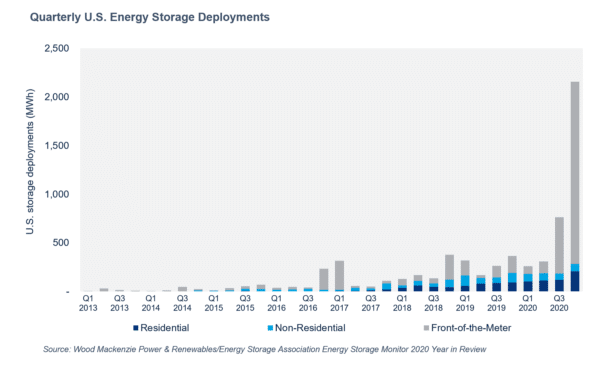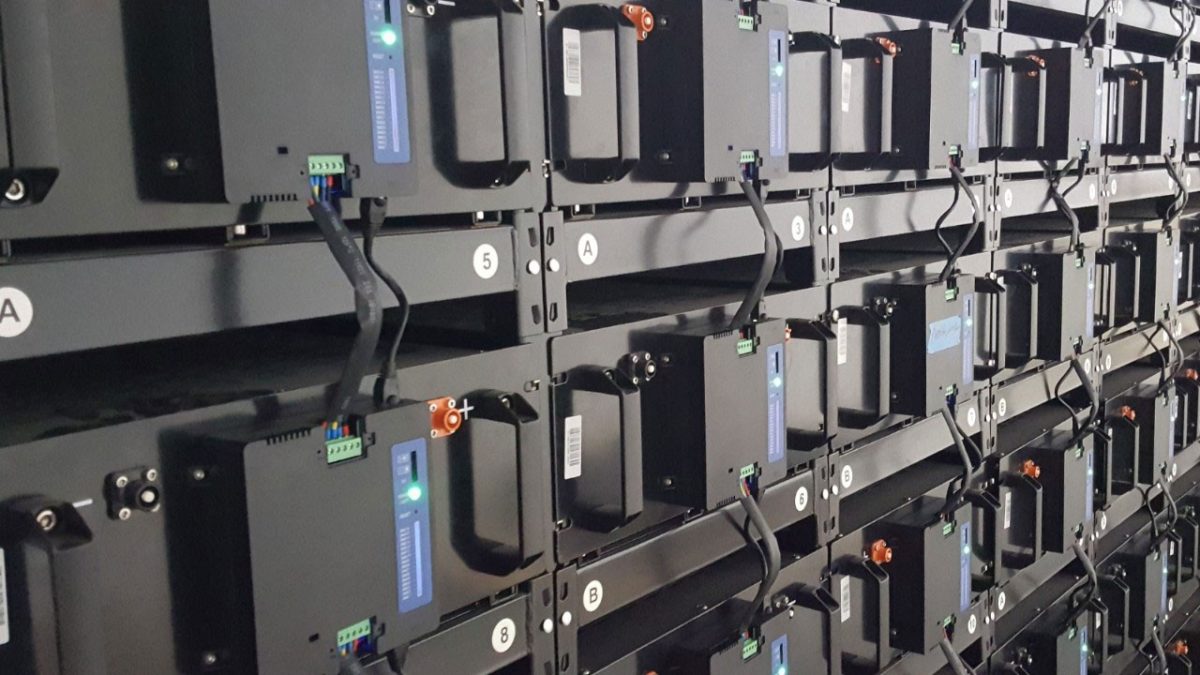A record amount of energy storage systems came online in the fourth quarter, according to Wood Mackenzie and the U.S. Energy Storage Association’s (ESA) US Energy Storage Monitor. The report said that 2,156 MWh of storage entered service, a jump of 182% from the third quarter.
Overall, 2020 was the first year that advanced energy storage deployments surpassed gigawatt scale, the report said.
 Falling prices along with eroding barriers to deployment are driving front-of-the-meter (FTM) storage adoption in the U.S. , the report said. Four out of every five megawatts deployed during the quarter was FTM storage. The segment contributed 529 MW out of the total 651 MW of storage that was deployed.
Falling prices along with eroding barriers to deployment are driving front-of-the-meter (FTM) storage adoption in the U.S. , the report said. Four out of every five megawatts deployed during the quarter was FTM storage. The segment contributed 529 MW out of the total 651 MW of storage that was deployed.
Residential storage projects totaled 90.1 MW, and made up 14% of the megawatt total during the quarter, driven in large part by homeowner interest in California. Expectations are that Texas will be a big growth market in 2021 in the aftermath of extended power outages across the state as a result of a mid-February winter storm.
Massachusetts led the non-residential segment, which is growing more slowly than the other two storage segments; deployments totaled 76.5 MWh during the quarter.
For 2020 overall, 1,464 MW / 3,487 MWh of new storage came online in the U.S. In megawatt terms, 179% more storage was added in 2020 than in 2019.
The U.S. installed 3,115 MWh of storage from 2013 through 2019, the report said, a total that 2020 beat in a single year.
In February, IHS Markit said that global utility-scale energy storage installations this year are set to exceed 10 GW for the first time. That’s more than double the 4.5 GW installed in 2020. IHS said the U.S. will account for 50% of that total.
FedEx carbon-neutral goal
FedEx is earmarking more than $2 billion to advance its vehicle electrification, sustainable energy, and carbon sequestration efforts, part of its plan to become carbon-neutral by 2040.
It said that by that date, its entire parcel pickup and delivery fleet will be made up of zero–emission electric vehicles. By 2025, half of those vehicle purchases will be electric, rising to 100% by 2030.
The company said it will continue efforts to make its roughly 5,000 facilities worldwide more sustainable through investments in efficient facilities, renewable energy, and other energy management programs.
The investment includes a pledge of $100 million to set up the Yale Center for Natural Carbon Capture, intended to back research into methods of carbon sequestration at scale, with an initial focus offsetting greenhouse gas emissions equal to current airline emissions.
Patents for perovskites
Hunt Perovskite Technologies (HPT) said that the United States Patent and Trademark Office granted it two patents related to its development of printed metal halide perovskite photovoltaic devices.
The first patent (US10,907,050) relates to HPT’s invention of an ink to print nickel oxide as a high-performance interfacial layer in perovskite PV devices. The second patent (US10,916,712) relates to HPT’s invention of a printed, durable carbon electrode for planar architecture perovskite PV devices.
The company owns one of the largest perovskite PV patent portfolios in the U.S. Hunt now holds 24 patents granted in the U.S. and another 45 patents by various foreign patent offices, along with pending applications in Materials-Level Durability, Device-Level Durability, Ink Chemistry and Processing, and Device Testing/Metrology.
Aerial imagery partnership
Residential solar installation company Zenernet and EagleView, a provider of aerial imagery and data analytics, are partnering to improve the measurement and design process for homeowners. Washington State-based EVEagleView will provide precise remote property measurements, removing the need for site visits and better ensuring accurate estimates, plan sets, and designs.
Zenernet said it has seen initial sale to final permit-ready plan timeline fall from around 30 days to 72 hours.
The imagery includes oblique imagery that is captured at a 45-degree angle to provide a 3D view of the property. EagleView claims accuracy to within fractions of an inch. The process is remote until system install, and is expected to optimize both speed and overall design results.
This content is protected by copyright and may not be reused. If you want to cooperate with us and would like to reuse some of our content, please contact: editors@pv-magazine.com.









By submitting this form you agree to pv magazine using your data for the purposes of publishing your comment.
Your personal data will only be disclosed or otherwise transmitted to third parties for the purposes of spam filtering or if this is necessary for technical maintenance of the website. Any other transfer to third parties will not take place unless this is justified on the basis of applicable data protection regulations or if pv magazine is legally obliged to do so.
You may revoke this consent at any time with effect for the future, in which case your personal data will be deleted immediately. Otherwise, your data will be deleted if pv magazine has processed your request or the purpose of data storage is fulfilled.
Further information on data privacy can be found in our Data Protection Policy.